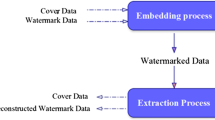Abstract
The run-length coding and the morphological representation are two classical schemes for wavelet image coding. The run-length coders have the advantage of simplicity by recording the lengths of zero-runs between significant wavelet coefficients but at the expense of yielding an inferior rate-distortion performance. The morphology-based coders, on the other hand, utilize the morphological dilation operation to delineate the clusters of significant coefficients for improving coding performance. In this paper, a novel dilation-run image coding algorithm is developed by taking the advantages of both schemes, in which the clustered significant coefficients are extracted by using the morphological dilation operation and the insignificant coefficients between the extracted clusters are coded by using the run-length coding method. The proposed dilation-run image coder is implemented in the framework of bitplane coding for producing embedded bitstreams. Compared with several state-of-the-art wavelet image coding methods, the proposed dilation-run image coding method achieves comparable rate-distortion coding performance, especially more attractive for fingerprint type of imageries.
Similar content being viewed by others
References
Shapiro J.M. (1993). Embedded image coding using zero trees of wavelet coefficients. IEEE Trans. Signal Process. 41(12): 3445–3462
Said A. and Pearlman W.A. (1996). A new, fast and efficient image codec based on set partitioning in hierarchical trees. IEEE Trans. Circuits Syst. Video Technol. 6(3): 243–250
Tsai M.J., Villasenor J.D. and Chen F. (1996). Stack-run image coding. IEEE Trans. Circuits Syst. Video Technol. 6(5): 519–521
Servetto S.D., Ramchandran K. and Orchard M.T. (1999). Image coding based on a morphological representation of wavelet data. IEEE Trans. Image Process. 8(9): 1161–1174
Chai B., Vass J. and Zhuang X. (1999). Significance-linked connected component analysis for wavelet image coding. IEEE Trans. Image Process. 8(6): 774–784
Taubman D. (2000). High performance scalable image compression with EBCOT. IEEE Trans. Image Process. 9(7): 1158–1170
JPEG 2000 Part I, Final Committee Draft Version 1.0, ISO/IEC JTC-1/SC 29/WG-1, N1646R, Mar. 2000
Tian, J., Wells, R.O. Jr.: A lossy image codec based on index coding. In: Proc. IEEE Conf. on Data Compression, pp. 456. 31 March–3 April, 1996
Tian J. and Wells R.O. Jr (1998). Embedded image coding using wavelet difference reduction. In: Topiwala, P.N. and Norwell, M.A. (eds) Wavelet Image and Video Compression., pp 289–301. Kluwer, Dordrecht
Walker, J.S., Nguyen, T.Q.: Adaptive scanning methods for wavelet difference reduction in lossy image compression. In: Proc. IEEE Int. Conf. Image Processing, vol. 3, pp. 182–185, 10–13 Sept. 2000
Yuan, Y., Mandal, M.K.: Context-modeled wavelet difference reduction coding based on fractional bit-plane partitioning. In: Proc. IEEE Int. Conf. Image Processing, vol. 2, pp. 251–254. 14–17 Sept. 2003
Berghorn W., Boskamp T., Lang M. and Peitgen H.O. (2001). Fast variable run-length coding for embbedded progressive wavelet-based image compression. IEEE Trans. Image Processing 10(12): 1781–1790
Zhong J.M., Leung C.H. and Tang Y.Y. (2000). Image compression based on energy clustering and zero-quadtree representation. Proc. IEE Vision, Image and Signal Processing 147(6): 564–570
Lazzaroni F., Leonardi R. and Signoroni A. (2003). High-performance embedded morphological wavelet coding. IEEE Signal Process. Lett. 10(10): 293–295
Maragos P. and Schafer R. (1990). Morphological systems for multidimensional signal processing. Proc. IEEE 78(4): 690–710
Vincent L. (1993). Morphological grayscale reconstruction in image analysis: Applications and effective algorithms. IEEE Trans. Image Process. 2(2): 176–201
Antonini M., Barlaud M., Mathieu P. and Daubechies I. (1992). Image coding using wavelet transform. IEEE Trans. Image Process. 1(2): 205–220
Witten I.H., Neal R.M. and Cleary J.G. (1987). Arithmetic coding for data compression. Commun. ACM 30(6): 520–540
Bradley J.N. and Brislawn C.M. (1994). The wavelet/scalar quantizaton compression standard for digital fingerprint images. Proc. IEEE Int. Symp. Circuits Syst. 3: 205–208
Author information
Authors and Affiliations
Corresponding author
Rights and permissions
About this article
Cite this article
Wu, Z., He, MY. & Ma, KK. Dilation-run wavelet image coding. SIViP 2, 225–239 (2008). https://doi.org/10.1007/s11760-008-0052-9
Received:
Revised:
Accepted:
Published:
Issue Date:
DOI: https://doi.org/10.1007/s11760-008-0052-9




